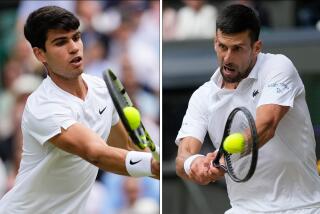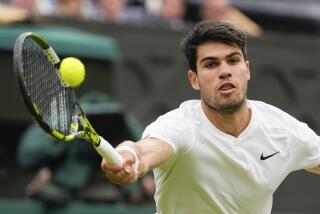Grass Still Greener on Centre Court : Hard Changes Elsewhere Wonât Pave Way for New Surface at Wimbledon
WIMBLEDON, England â Fertilize it. Weed it. Water it. Mow it. Rake it. Feed it to livestock. That is what you do with grass.
But play tennis on it? Well, that too.
This may not have happened if Alexander Shanks of Scotland hadnât invented a machine called a lawn mower.
The new grass-cutting device made it possible to keep lawns at a uniform height, which eventually led to the birth of Wimbledon, the most uniform of all tennis tournaments.
Players and fans alike must follow the rules set down by the All England Lawn Tennis & Croquet Club. Anything else wouldnât be, well, cricket.
Boris Becker made such a discovery this week when he had the audacity to try putting his sneakers on the precious grass without showing his pass at the gate. Of course, he was turned away. No exceptions.
The pregnant wife of former champion Stan Smith once tried to watch her husband play from the membersâ balcony, but a security guard halted her.
âThis is a membersâ balcony,â the guard said.
âBut I just want to see my husband play and heâs a member,â Maggie Smith said.
âExactly, Mrs. Smith, and youâre not,â said the guard.
Cheerio.
Pipe and cigar smoking is prohibited at Centre Court, the shrine of tennis, which seems reasonable because one should never light up in church anyway.
And since this is England, the teapot is always warm. At Wimbledonâs concession stands, those who drink tea are warned by a large sign: âSpectators are requested NOT to take crockery or cutlery into the stands.â
In the U.S., itâs beer coolers. Here, itâs china.
The English uphold their tennis tradition with characteristic style. The subway station nearest the main entrance on Church Road is Southfields. When the train pulls into the station, the first thing tennis fans arriving from London see is this sign:
âAlight here for Wimbledon tennis.â
Alight? Just donât say that to someone with a pipe at Centre Court.
The big story here this week, besides tennis, is the discovery of a mouse on Court 1, apparently living in the electronic service line machine.
Fleet Street tabloids, in a flash of originality, named him Mickey.
There has already been one major controversy at Wimbledon this week. It was over food. No one took crockery into the stands. This was worse. The outcry was over the high cost of strawberries.
Four strawberries in a cup cost $2.55, or 64 cents apiece, compared to three cents apiece in the market. Pimms, the Wimbledon equivalent of the Kentucky Derbyâs mint julep, is very big here but strawberries and cream constitute the most important snack at this tournament, so you can imagine the outrage.
More than 20 tons of strawberries were expected to be consumed during the tournament, so Wimbledon officials listened, then issued a strawberry statement.
Smoothing over a potential explosive situation, they sliced the strawberry price by 30 cents. No adjustment was made in the cost of cream, which apparently is just along for the ride.
At times, the players feel thatâs why they are here. One of the biggest reasons is the grass.
The truth is, grass-court tournaments are anachronistic. And although that is acceptable here, there just arenât many events played on grass anymore.
There used to be an early-summer circuit of professional grass-court tournaments, but those events have disappeared. Hard courts are prevalent now.
For the Grand Slam events, there is a recent history of shifting from grass to concrete.
In 1977, the U.S. Open moved from the grass courts of Forest Hills to the hard courts of Flushing Meadow. Two years ago, the Australian Open left the cozy grass courts of Kooyong in Melbourne and moved to a hard-court site at Flinders Park.
Some believe it is inevitable that Wimbledon will someday cut its grass-court history. The official Wimbledon line of thinking reflects no such sentiment.
âThereâs no consideration or even thought to change,â said Roger Ambrose, secretary of the All England Club.
âWe are a grass-court championship. That is a Wimbledon tradition. We want it to remain so as long as possible. Thatâs one of the things that makes Wimbledon unique.â
Former Wimbledon champion Arthur Ashe does not believe grass is doomed but he thinks it has drawbacks.
âChange is a possibility, but itâs not a very strong possibility, even if it should be,â Ashe said. âWhen 11 of the top 60 players in the world are not here, theyâre not here because they donât want to be here.â
Actually, itâs 16 of the top 60, but three of them wouldnât be playing here anyway because they are injured: Thomas Muster, Emilio Sanchez and Henri Leconte.
The basic complaint of players about grass is that there is too little time to prepare for it--the French Open is played on clay only two weeks before--and that there are too few grass-court tournaments anyway.
Jimmy Connors, a two-time champion, said that Wimbledon tradition may be too strong to change.
âIt has been stuck here for such an amount of time that changing it may be difficult,â he said. âThis is all there is for grass now and I do not know if there is one day going to come a time when this will have to change also.
âWill there come a time when . . . you just make one universal surface? I felt when the Australian was on grass and the (U.S) Open was on grass, there was more of a chance to prepare yourself. Now it is difficult, especially coming right from the French.
âWhether I think it should change or not, my opinion doesnât matter.â
Martina Navratilova has won eight Wimbledon titles and she sees no reason for changing the surface.
âThere would be nothing to gain,â Navratilova said. âIf you went for what is convenient, then you would put (hard surfaces) on every court in this whole world and it would be awfully boring.
âThere would be no variety at all, then. It would hurt the game in the long run because everyone would play in the same way.â
Even more outspoken, as usual, was Romanian Ion Tiriac, Boris Beckerâs manager.
Change from grass? Tiriac would sooner shave his mustache.
âThis is history. This is tradition,â Tiriac said. âI would never, even if I could, put Wimbledon in Yankee Stadium in front of 100,000 people.â
The man in charge of the most prized lawn in tennis is Jim Thorn, whose title is head groundsman. Thorn may be the only groundskeeper in sports who is too big to do interviews.
However, he has prepared a release on how to build a grass court. Club secretary Ambrose retrieved it from his filing cabinet.
Each year, as soon as the tournament is over, every court is completely reseeded. Turf is not used because it might not grow together and leave seams, and also because it might not be uniform.
The seed mixture is 55% rye grass, 20% chewings fescue, 20% creeping red fescue and 5% Agrostis Castillana.
Before the courts are seeded, a careful procedure is followed, according to Thornâs plan. Ambrose revealed it.
âThe whole surface must be pricked by fork,â he said. âIf you have a spiking machine, so much the better. The object is to create a fine tilth to sow the seed into.â
Of course. This is agronomy. This is tennis. And at Wimbledon, they come together. Itâs tradition.
More to Read
Go beyond the scoreboard
Get the latest on L.A.'s teams in the daily Sports Report newsletter.
You may occasionally receive promotional content from the Los Angeles Times.










